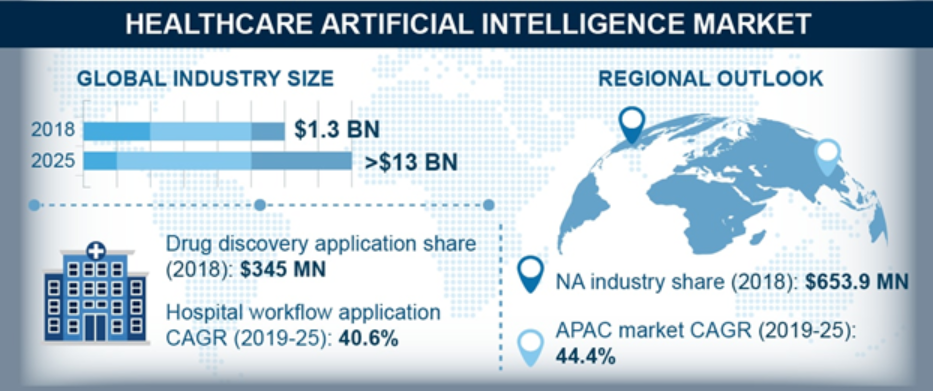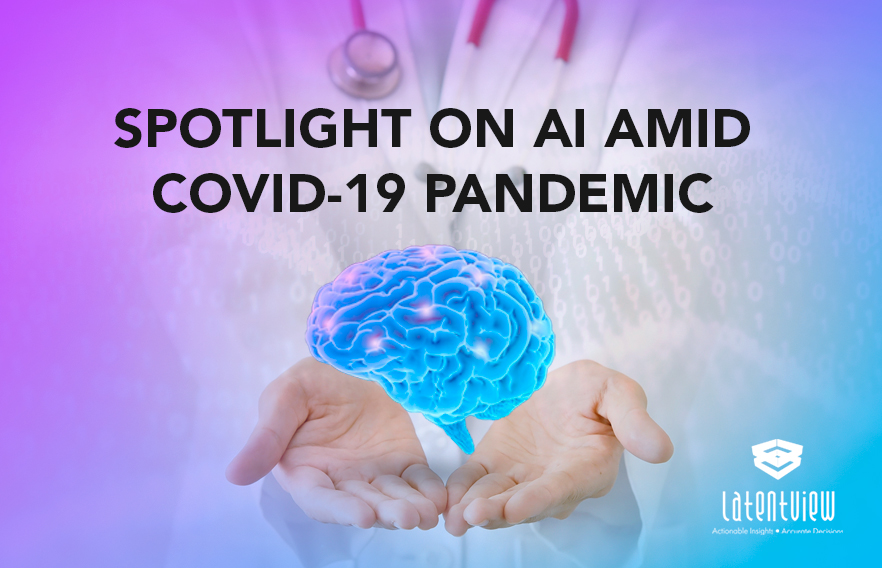Introduction
The power of Artificial Intelligence (AI) is encompassing all areas of life, but its impact on healthcare is truly life changing. AI is revolutionizing the health sectors in many ways, from drug development to clinical research, making better & faster decisions, de-stressing healthcare resources & infrastructure, bringing precision to processes, affordability and accessibility. According to a recent finding, 89% of healthcare respondents have cited increase in efficiency and 91% cited increase in patient access due to AI.
Top AI applications in healthcare include robot-assisted surgery, virtual nursing assistants, dosage error reduction, diagnostics using medical images (cancer cell detection, tumour information, etc.)
- Diagnostics – AI can be used to diagnose diseases by examining medical images in the form of X Rays, CT scans etc. A sufficiently sophisticated system will be able to aggregate image data with other types of medical data, and offer predictive diagnoses to individual patients to predict a myriad of health conditions like bone fractures,pneumonia, cancer, foreign object detection in body, fluids or tissues.
- Assistive AI – Applications can leverage AI and perform initial diagnostic assessments in the form of chatbots over a smartphone or computer interface. AI powered chatbots use speech or text recognition to compare the symptoms and medical history provided by the patient against a database of symptoms, diseases & diagnosis, and respond with a recommended course of action—such as going to the pharmacy to pick up over-the-counter cold medicine, dialling 911 or another emergency service hotline, or going directly to the hospital.
- Diagnostics – AI can be used to diagnose diseases by examining medical images in the form of X Rays, CT scans etc. A sufficiently sophisticated system will be able to aggregate image data with other types of medical data, and offer predictive diagnoses to individual patients to predict a myriad of health conditions like bone fractures,pneumonia, cancer, foreign object detection in body, fluids or tissues.
- Assistive AI – Applications can leverage AI and perform initial diagnostic assessments in the form of chatbots over a smartphone or computer interface. AI powered chatbots use speech or text recognition to compare the symptoms and medical history provided by the patient against a database of symptoms, diseases & diagnosis, and respond with a recommended course of action—such as going to the pharmacy to pick up over-the-counter cold medicine, dialling 911 or another emergency service hotline, or going directly to the hospital.
Market Size
The global AI valuation in the healthcare market was at $1,441 million in 2016, and is estimated to reach about $13 billion by 2025. These applications are projected to save $150 billion dollars in annual savings for the US healthcare economy by 2025 as per a report. Some of the top AI technology companies making a big splash in health care are Google DeepMinds, IBM Watson Health, Remedy Health, Subtle Medical and Quid and BioSymetrics.

Current Situation and challenges
In the recent global outbreak, COVID-19 virus which originated in the city of Wuhan has now affected close to 210 countries around the globe with about 1.9 million people affected, growing at a rate of 1.8% with a mortality rate of 12% according to this Report.
In such a pandemic, testing at a fast pace and scale becomes a very important part of the outbreak management process. Current testing methodologies are either PCR or Antibodies tests, results for which take about 2-3 days to come in. This is where AI can massively help in speeding up the diagnostics and help in reducing the strain on the healthcare system and infrastructure.
Solution
Computer Vision (subfield of AI) is used to extract the content of digital images by isolating the description from an image, object detection, image detection etc. More specifically, we provide the learning algorithm with many examples and they then learn to extract features and learn patterns to perform the task for which they are trained for.
Using the same principle AI can be leveraged to build a model using the Chest X Ray scans and detect traces of Virus. Patients with COVID-19 have certain visual hallmarks, such as ground-glass opacities—hazy darkened spots in lungs. Deep Neural Net algorithms can process the X Ray scans to automatically identify such features and score them within milliseconds. X Ray scan of Covid 19 affected lungs show hazy spots.
Below you can see few X-ray scan of patients without any virus:


At LatentView, we have developed a deep learning model that can perform autonomous diagnosis after processing the X Ray Scan image of patients. The solution uses the advancement in the area of Computer vision to extract fine grained features from the X-ray scans and use that to perform distinction. We leveraged a dataset published by Qatar university to train the model and score each scan on a scale of 0 to 1 , 1 being highly likely that the patient has COVID-19.
Model interpretability
To further provide more insightful predictions we utilized Gradient based class activation maps (Grad-CAM) ,a technique for making CNN based models more transparent by highlighting the regions where the model focused more while making predictions. This is a way to use the inherent attention mechanism of CNN and understand its output.
Below is an example showing the same, where the blue light is highlighting the area where the model focused more.

Making use of such a solution would have several advantages, some of which are –
- Ultra Fast diagnosis (milliseconds)
- Can operate at scale & Cost effective
- Localisation of virus traces or area of focus
- Acts as first in line diagnosis, thereby assisting doctors in prioritising.
- Easy to deploy on cloud and make it accessible.
Limitations
Although AI can be leveraged in different ways in Healthcare with far reaching impact, there are certain limitations that pose a challenge for a 100% adoption rate, which can be solutionized in future.
- The results of the AI enabled test are preliminary and need a deeper diagnosis by practitioner at this stage
- More data is needed to evaluate the accuracy and Sensitivity
- Data privacy & data security issues need to be addressed
- Data centralisation – healthcare data must be in a shareable infrastructure
- Solutions needs to be approved by a globally medical accredited institution
Conclusion
The future is looking at technology and data and it is no doubt that Artificial Intelligence in healthcare is the right step in that direction. AI adoption in healthcare is more necessary than ever to absorb the sheer volumes of patients, diseases & diagnosis and to be able to automate routine procedures and enable the medical practitioners to be more productive and less fatigued at reduced costs to the public.
Overcoming the challenges for AI adoption will need all the stakeholders like doctors, patients, regulatory authorities to agree and form a mutual ground and enable the AI systems to behold the future in healthcare.



